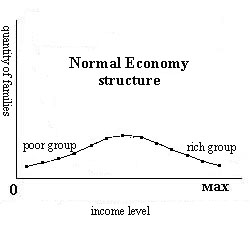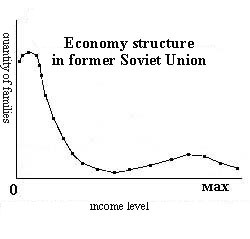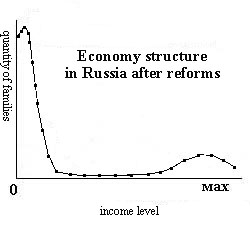The absence of a middle class: the cause or the result of the failure of economic reforms?Anna Vasilyeva, Elena Chernomazova
The childlish «chicken-and-egg» problem is not so primitive as it may seem to high minds troubled with the routine of our life. Something that looks like a result may happen to be a cause, and vice versa. Many illustrations to this are easy to find. For example, one could take the processes in today’s Russian economy. In the beginning of reforms many people believed that switching to market economy would foster the formation of middle class in Russia, that large group of people with middle incomes which insures political and social stability and economic growth in developed western countries. Unfortunately, these hopes were to fail. To straighten out the reason for the collapse of market reforms in Russia we asked for the help of a Fellow of Russian Academy of Economic Sciences (RAEN), professor Dmitry Sergeevich Chernavsky. In the 80-es he developed a model which explained the dependence of economic processes on the proprietary stratification of the society. But let us provide you with a few facts for the beginning. The Russian middle class before and after the crisisAccording to the information of the Institute of the social and economic problems of the population (Russian Academy of Sciences) there were 3 to 4 percent prosperous families in our country with monthly per capita income over 1500 dollars. Over 60 percent families had a monthly income of less than 100 dollars per capita and were living on the poverty line. About 31-33 percent of the Russian population had an average monthly income from 150 to 1500 dollars per capita and related to the middle class. 15 percent of the population with the per capita income from 150 to 400 dollars formed the lower level of the middle class. According to world standards people can be classed among the middle class if they spend less than one third of their monthly income on food, while representatives of the Russian lower middle class spend about 40 percent of their budget on food. They could be included in the middle class by a considerable stretch. The monthly income of the middle level of our middle class (about 10% of the population) was 400 to 800 dollars per person. Only 6-8 percent of Russian citizens had an income of 800 to 1500 dollars monthly which placed them in the upper level of Russian middle class. As a matter of fact, only this group’s expenditures reached middle class standards of the majority of European countries. The «happy medium» of our society did not have time to strengthen enough and suffered a crushing blow at the end of last summer. Its «untimely death» was the most regretted event in Russian mass media. One doesn’t have to be sorry for the rich, nobody can think of the way to help the poor, and the middle class really needs our sympathy. According to the forecasts about 10 million members of the middle class will join the poor before long. Additionally, 5 million well-off people will lose much of their monthly income, which will fall to approximately 200-500 dollars per capita, and this means they will join the lower middle class. People who could be related to the upper middle class will suffer to a lesser degree. Their number will even increase because their ranks will be joined by the yesterday’s rich. In general, the sociologists estimate the number of Russians whose incomes will decrease as 20 million people. In the near future the poor will make up 75 to 77 percent of the population, and the size of the middle class will decrease to 20-21%. To have one hump is better than twoMany people, then, find the dark prospects for middle class to be connected with the August crisis. But professor Chernavsky’s point of view is different: to his mind, the absence of middle class is not the result but the main reason of the failure of economic policy of Russian reformers. Chernavsky believes that successful development of free market economy is possible only under certain conditions, namely when the strong and numerous middle class is present. Dmitry Sergeevich has come to this conclusion by the analysis of pricing dynamics and following economic processes in the societies with different income group structure. Income distribution of the population in the developed western countries forms a one-hump curve (the horizontal axis of the chart shows the citizens’ savings, while the vertical axis shows the number of families with the given savings). (See chart 1). The peak corresponding to the highest number of people is located at the medium level of income, which means that the prevailing population group is middle class. It includes skilled workers, beginner businessmen, civil servants – all these people with various professions and levels of education have about the same income and constitute the majority of the population. Chart 1
Chart 2
Let’s start with the two-hump distribution by income that took place in our country. Suppose that a marketer would like to sell 100 kg apples. Low-income purchasers could buy it all up for 1 ruble per kilo, then the seller’s profit will make 100 rubles. Purchasers with high income could well afford to buy apples for 10 rubles per kilo, but as rich customers are scarce the marketer can sell only 30 kg apples for that price. They will fetch 300 rubles, and not 100. Next year he will grow only 30 kg and fire some of his workers. That was the thing to happen in our country after the reforms had started. Liberation of prices led to their growth. The prices rose up to the level when only the richest 25% of the population could afford them. Manufacturers had more benefit if they sold 25% of their goods and overcharged them, so it was no use for them to keep the prices affordable for the majority and the sales – at the old level. Low-income population had to cut down on their purchases to the minimum. As they had constituted the majority of purchasers before the reforms, the market overflowed with goods. That was naturally followed by the rise of unemployment and decrease in production in all branches of industry. At the present time the gap between the levels of income of the rich and poor is not diminishing, just the opposite – it’s even widening. This leads to further deepening of the economic crisis. 80 percent of population with low income possess only 9 percent of savings. 20% population with high income have about 54 percent of all savings. The least numerous group (0.2% or the «tail» of the curve) have 32 percent of savings. Chart 3
What should we do if we have two humps?It is obvious that Russian economy won’t get out of crisis with the current income structure, because in such a society free market economy automatically leads to inflation and decrease in production.
To the point of view of Dmitry Sergeevich, one of the ways out of crisis is the introduction of partially planned production. It means subsidizing of large enterprises under the warranty of making a certain amount of produce. It was calculated that the 30% award is the most efficient. Enterprises could use the remaining capacities at their discretion, which would provide their effective response to changes of the market condition. Professor Chernavsky thinks that the pricing policy of the state should take into account the low-income group of the population, possibly by defining a price range for essential goods. But all these measures won’t have any significant impact if we don’t get rid of the first cause of the current situation – uneven income distribution. The latter, said Dmitry Sergeevich, could be done by the means of sensible note issue addressed to the certain group of citizens: engineers of major plants, skilled workers, defense industry workers and some of the others. It would rise their income and keep it closer to the medium level. Professor Chernavsky also stresses the role of sensible taxing policy which would take some of the burden off domestic manufacturer by supertaxing excess profits.
|

 The situation that took place in the USSR in late stagnation years was very different. The chart of distribution by income levels was a two-hump curve. The first peak corresponded to the low-income majority (low- and medium-paid agricultural workers, blue-collar workers, clerks who spent all their income on everyday needs). The second peak corresponded to the population with high income level (those relatively rich people who constituted about 25% population included salespersons, skilled blue-collar workers, engineers working in the defense industry and some others). The incomes of the poor and rich groups were significantly different, but the main thing was that between them there were practically no people with medium level income.
The situation that took place in the USSR in late stagnation years was very different. The chart of distribution by income levels was a two-hump curve. The first peak corresponded to the low-income majority (low- and medium-paid agricultural workers, blue-collar workers, clerks who spent all their income on everyday needs). The second peak corresponded to the population with high income level (those relatively rich people who constituted about 25% population included salespersons, skilled blue-collar workers, engineers working in the defense industry and some others). The incomes of the poor and rich groups were significantly different, but the main thing was that between them there were practically no people with medium level income.
 By the middle 80-es the soviet economy has come to a dead end and needed reforming. On the one hand, it was depressed by administrative management and on the other hand – by shadow operations. The prices that had not changed during the last 40 years were being artificially lowered. The economists thought that the prices should be increased 3 to 4 times in that situation. But the reforms of 1992 caused the complete liberation of prices. They shot up 70-fold, which led to even heavier consequences for the economy. If we take a look at how the two models (one-hump and two-hump) behave under free market conditions, we’ll see why it happened.
By the middle 80-es the soviet economy has come to a dead end and needed reforming. On the one hand, it was depressed by administrative management and on the other hand – by shadow operations. The prices that had not changed during the last 40 years were being artificially lowered. The economists thought that the prices should be increased 3 to 4 times in that situation. But the reforms of 1992 caused the complete liberation of prices. They shot up 70-fold, which led to even heavier consequences for the economy. If we take a look at how the two models (one-hump and two-hump) behave under free market conditions, we’ll see why it happened.
 In the society with one-hump distribution the pattern of economic processes is just the opposite. Let’s return to our marketer who wants to sell 100 kg apples. Prosperous customers can still pay 10 rubles for a kilo of apples. But the seller can realize only 30 kg for that price and make 300 rubles. Middle class customers can pay 5 rubles per kilo. But as the majority of the population belongs to the medium income group the marketer can sell all his 100 kg and make 500 rubles. The artificial inflation of prices will only cause the seller to have losses. His income will be highest if he sells the maximum amount of goods for the price that is affordable for the middle class. The production should be steadily high to provide the necessary amount of goods for the market, and therefore the level of employment of the population will also be steady.
In the society with one-hump distribution the pattern of economic processes is just the opposite. Let’s return to our marketer who wants to sell 100 kg apples. Prosperous customers can still pay 10 rubles for a kilo of apples. But the seller can realize only 30 kg for that price and make 300 rubles. Middle class customers can pay 5 rubles per kilo. But as the majority of the population belongs to the medium income group the marketer can sell all his 100 kg and make 500 rubles. The artificial inflation of prices will only cause the seller to have losses. His income will be highest if he sells the maximum amount of goods for the price that is affordable for the middle class. The production should be steadily high to provide the necessary amount of goods for the market, and therefore the level of employment of the population will also be steady.